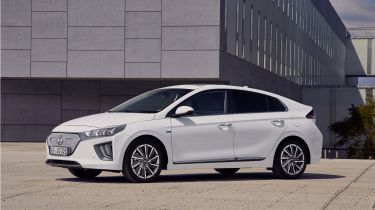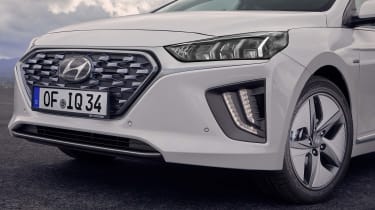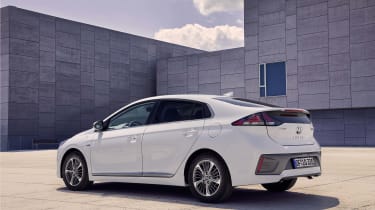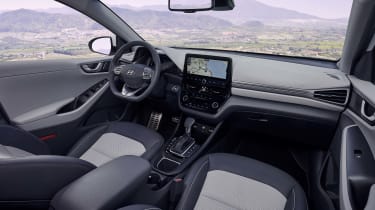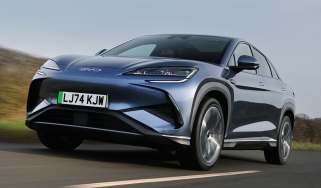Facelifted Hyundai Ioniq on sale now
New styling and technology for the Hyundai Ioniq, which starts at £22,795
The facelifted Hyundai Ioniq starts from £22,795 and is on sale now. The new version of Hyundai’s rival to the Toyota Prius is still available as a hybrid, plug-in hybrid and as a fully electric vehicle (EV). The facelift for the Ioniq range includes styling changes, technology improvements and increased range for the electric model. The revised model has also been tested been re-tested by Euro NCAP, again receiving a five-star safety rating.
The hybrid version is available in four trims, with all of them including automatic headlights with high-beam assist, rear parking sensors, cruise control and an eight-inch touchscreen with Apple CarPlay and Android Auto. The Premium model, which starts at £24,695, adds alloy wheels, LED headlights, heated front seats, a bigger touchscreen, sat nav and keyless entry/start. For a short time, a 1st Edition trim will be available; it adds bigger wheels, lane follow assist and an electric handbrake from the top-spec Premium SE trim for £260 extra. Premium SE starts at £26,995.
Choose the plug-in hybrid Ioniq and there are two trim options. Premium (£29,950) includes the same features as the hybrid, but adds wireless phone charging, climate control, a heated steering wheel and adaptive cruise control. For an extra £2,000, Premium SE adds privacy glass, leather, heated and ventilated front seats, an electric driver’s seat and heated rear seats, which is the same on the hybrid model. The electric model also comes in Premium and Premium SE trims, costing £29,450 and £31,450 respectively after the £3,500 plug-in car grant.
The Hyundai Ioniq Electric now has a much larger battery - a 38.3kWh battery replaces the outgoing 28kWh unit - and this is good news for how far you can travel between charges. Official range is now up to 193 miles, placing the car between the two Nissan Leaf variants but behind the Hyundai Kona Electric. The Ioniq gets an upgraded charging port to reduce charge times, making an 80% charge possible in 54 minutes using a 100kW charger.
The hybrid and plug-in models both benefit from minor improvements too. While they use the familiar 1.6-litre GDI petrol engine, the hybrid can now run on electric power alone at speeds of up to 75mph. The plug-in offers an electric range of 32 miles, calculated on the stricter WLTP test cycle. Hyundai claims up to 63mpg for the hybrid and 257mpg for the plug-in hybrid.
Both these models have the Eco Driving Assist System (Eco DAS), which works with the sat nav to see when the car can coast so that the engine can be turned off to save fuel. This works when you’re in Eco mode, as does the regenerative braking feature that captures the energy created by braking.
The Electric model extends regenerative braking to the point where you can drive the car using just the accelerator. Hyundai says the car will automatically adjust the level of braking, depending on the gradient of the road and traffic conditions. There’s a new Eco+ driving mode alongside Eco, Comfort and Sport modes.
The exterior changes to the Ioniq range are small but you can tell old and new apart by new grilles and wheel designs, and tweaked headlights and tail-lights, which are now LED units. Wheel options are 16 inches for the electric and plug-in models, and a choice of 15-inch or 17-inch wheels on the hybrid, with the latter slightly affecting fuel economy and CO2 emissions. Rounding up the design changes are four new paint colours, bringing the choice to nine in total.
Inside, the changes are more noticeable, as there’s a new 10.25-inch infotainment screen in the main part of the centre console. The seven-inch digital instrument cluster has been updated, as has the design of the heating controls. New ambient lighting is included, and there are four new leather upholstery options.
Also new is the Blue Link connectivity feature, which allows you to remotely control some of the car’s functions through a smartphone app. All models offer remote locking, unlocking and air conditioning, and the electric model also offers remote-starting, charging control and a real-time battery status.
If you specify sat nav, Hyundai will now include a five-year subscription to its live services, so you’ll see up-to-date information about traffic, weather, nearby chargers, points of interest, local dealers and speed camera warnings. Automatic emergency services calling is now included, too, and the car can call for an ambulance or police in the event of a collision.
Hyundai has also revised their SmartSense suite of safety kit as well, with lane-keep assist, auto high-beam activation, pedestrian and cyclist detection, avoidance assist and a driver attention warning all fitted as standard. You can also choose blind-spot and rear cross-traffic monitoring as options. The facelifted Ioniq has been re-tested by Euro NCAP, with the hybrid, plug-in hybrid and pure-electric variants all maintaining it's five-star safety rating.
Read our reviews of the different Ioniq models on our Hyundai main page for more information.
Most Popular

New Land Rover Defender Sport spotted and it’s an electric baby SUV
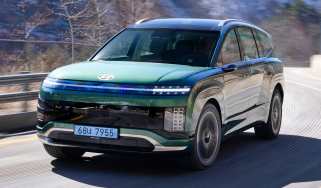
Hyundai Ioniq 9 review – incredibly practical seven-seat EV with impressive range
Tips & advice

Car dashboard warning lights: what does each symbol mean?

Electric car charging stations: public networks, charger types, apps and maps


